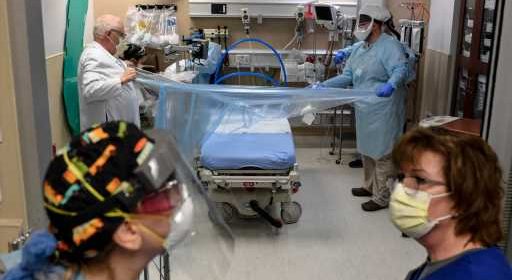Older Coloradans should maintain higher level of social distancing to prevent overwhelming hospitals, officials say

Older Coloradans need to practice more stringent social distancing than younger residents in the coming months if the state is to avoid exceeding its critical care hospital capacity later this summer, according to a new modeling report released Tuesday.
The modeling, compiled by a group of experts from the Colorado School of Public Health, predicts that if Colorado moves to lower levels of social distancing this summer, older adults will need to remain at stay-at-home levels of movement in order to avoid exceeding hospital capacity.
“If only half of older adults adopt high levels of social distancing under a 55% social distancing scenario, the state is at risk of exceeding hospital capacity this summer,” the report states.
Colorado’s top public health experts and Gov. Jared Polis on Tuesday said current trends for hospitalizations, new cases and deaths all have been positive. But their modeling shows certain levels of distancing must be maintained — and the risk remains high for those over 60.
“We’re in a good place,” Dr. Jon Samet, dean of the Colorado School of Public Health, said on a conference call with reporters. “Now we need to look forward to see how we stay in a good place.”
As restrictions are relaxed and people move around more, viral transmission will increase, health officials said. And by mid-August, when schools gear up to reopen, the epidemic curves under all scenarios are rising, said Jill Hunsaker Ryan, executive director of the Colorado Department of Public Health and Environment.
How high those levels rise, however, all depends on levels of social distancing — particularly among older individuals.
Social distancing levels can be thought of as how much interaction one has with others compared with what they were doing in January. So 65% social distancing — the levels seen during safer-at-home — would be reducing social interactions by a little more than half. During the stay-at-home order, Colorado maintained roughly 80% levels of social distancing.
State health officials on Tuesday presented several scenarios for the coming months, based on their modeling.
In one scenario, experts modeled what would happen if all Coloradans, regardless of age, practiced social distancing at the same levels. Under these circumstances, the state’s ICU bed capacity would be exceeded at 55% and 45% social distancing levels. Only at 65% social distancing would hospitals have enough beds for the sickest COVID-19 patients.
If all adults over 60 maintained 80% social distancing levels — the same as under the stay-at-home order — then hospital capacity would not be exceeded if the rest of the population hit 65% and 55% distancing levels.
If half of older adults stayed at 80% distancing, ICU bed needs would still be topped even if the rest of the state maintained 65%, 55% or 45% levels, the modeling shows.
“The most vulnerable need to take measures to protect themselves,” Samet said.
Absent use of all strategies, Colorado could face a second peak by late summer, public health experts predicted in the report.
By the end of this week, health officials and experts expect to have a better sense of the effects from the safer-at-home order, which in Denver and much of the surrounding region did not begin until May 8.
During a news conference Tuesday, Polis said the modeling is “instructive, not determinative,” noting that he also takes into account other national and international models as he decided on future policies.
“I don’t have a crystal ball,” Polis said.
The governor also said he envisions a “slow return to normalcy” on courts handling eviction notices. Those processes stopped in April and May, and housing advocates have argued for rent freezes given the record-high unemployment levels in the state.
And in a win for frontline workers, Polis announced the state agreed on a 17-month contract with Honeywell for 6 million N95 masks, while another shipment of personal protection equipment designated for nursing homes should be arriving soon from the federal government.
Source: Read Full Article